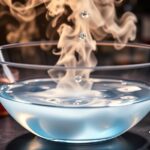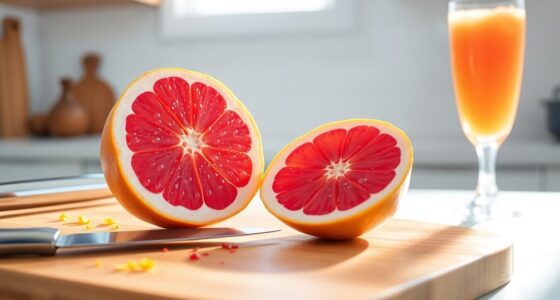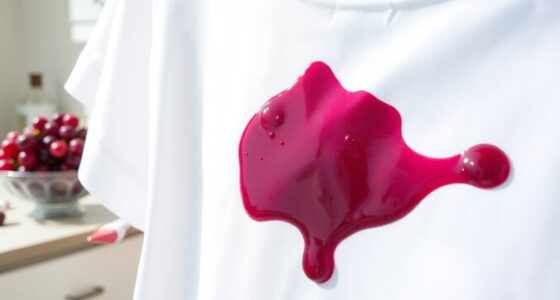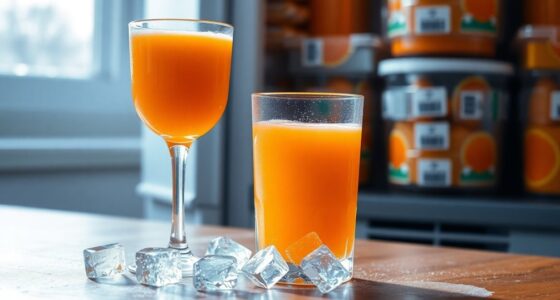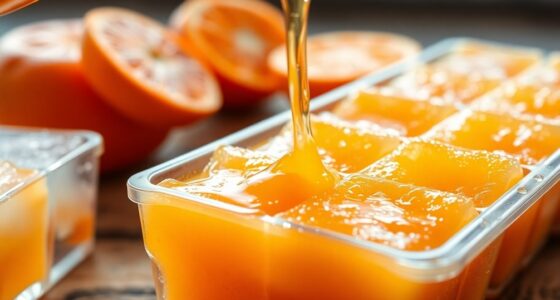To make your own fog juice, mix distilled water with vegetable glycerin. For thicker fog, use a ratio of 30% glycerin to 70% water. Combine the ingredients in a clean, airtight container, stirring well. For preservation, add a couple of drops of bleach per liter. Store the mixture away from sunlight and heat. Always test small amounts in your fog machine first, adjusting the ratio for desired fog density. Discover more tips to enhance your fog experience!
Key Takeaways
- Combine 30% vegetable glycerin with 70% distilled water for thick fog or adjust to 15% glycerin for lighter fog.
- Mix the glycerin and water in a clean, airtight container, stirring thoroughly to ensure proper blending.
- Add 2-3 drops of bleach per liter for preservation and to prevent bacterial growth.
- Test the mixture in your fog machine, adjusting the glycerin and water ratio to achieve desired fog density.
- Store fog juice in an airtight container, away from sunlight and heat, and label with the preparation date.
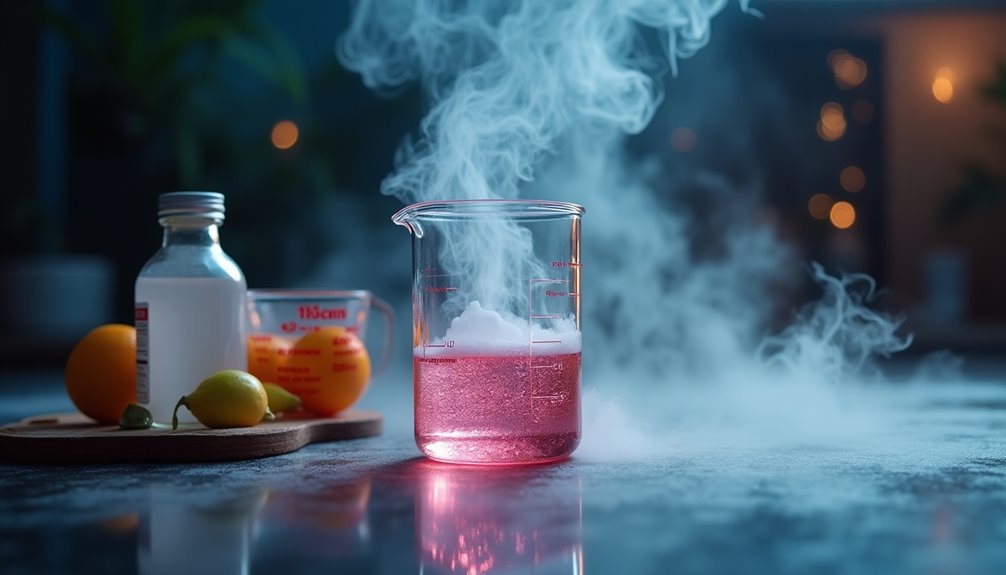
If you want to create your own fog juice for use in fog machines, it’s a simple process that can enhance your events or performances. Making homemade fog can be both cost-effective and satisfying, allowing you to customize the density and quality of the fog fluid to suit your needs. The primary ingredients required are distilled water and vegetable glycerin, which work together to produce the fog effect you’re after. To get started, you’ll need to combine three parts of distilled water with one part vegetable glycerin in a clean container. Stir the mixture thoroughly to ensure the ingredients are well-blended, and then pour it into your fog machine’s reservoir. If you’re curious about how to make fog juice, simply follow this recipe and fine-tune the ratios based on your desired fog density to achieve the perfect atmosphere for any occasion.
To begin, you'll want to gather your ingredients. It's essential to use distilled water, as this type of water keeps mineral buildup at bay, protecting your fog machines from damage and ensuring optimal performance. You can find distilled water in gallon jugs at most grocery or convenience stores.
Next, grab some vegetable glycerin, which you can typically find in health food stores or online. The ratio of these two ingredients will determine the thickness of your fog. For a thicker smoke, aim for a mix of roughly 30% glycerin to 70% water. If you prefer a lighter fog, reduce the glycerin to about 15%, using 85% water instead.
Once you've decided on your ratio, measure out the ingredients accordingly. Combine them in a clean container, preferably one that's airtight to maintain the quality of your fog juice. The cleaner your mixing vessel, the less chance there's for contamination.
After mixing, give it a stir to ensure the components blend well. To extend the shelf life of your fog fluid, consider adding 2-3 drops of bleach for each liter of fog juice. This can help prevent bacterial growth, ensuring that your homemade fog remains usable for a longer period.
Now that you've prepared your fog juice, it's time to test it out in your fog machine. It's wise to start with small amounts to see how it performs. This testing phase allows you to gauge the fog's density and quality before using larger quantities in your event.
Adjust your mixture as necessary to achieve the desired effect. You might find that you want to tweak the glycerin and water ratio depending on the specific fog machine you're using, as different machines may have varying requirements.
If you're feeling adventurous, you can also infuse your homemade fog with essential oils for a unique, aromatic experience. Just be cautious with the amount; a few drops can go a long way. Keep in mind that the essential oils could impact the performance of the fog machine, so always conduct a test run before the big day.
Frequently Asked Questions
How Do I Make My Own Fog Juice?
To make your own fog juice, start by mixing glycerin with distilled water.
You can use a 30% glycerin to 70% water ratio for thick fog, or adjust it to 20% and 80% for medium density.
Grab your ingredients from local stores, then thoroughly mix them in a clean container.
Store any leftovers in a sealed container away from impurities.
If you want, add a few drops of bleach for extra shelf life.
What Is the Main Ingredient in Fog Juice?
The main ingredient in fog juice is vegetable glycerin. This colorless, odorless liquid is derived from plant oils and is safe for inhalation at recommended concentrations.
When you mix glycerin with distilled water, it creates a vapor that turns into fog when heated in a fog machine. This combination enhances the atmosphere at events or theatrical performances, making it an essential component for anyone looking to create that dramatic effect.
Can You Use Distilled Water for a Fog Machine?
Yes, you can use distilled water for a fog machine, and it's actually the best choice.
Distilled water contains no minerals, which prevents buildup in the machine's pipes. This helps maintain optimal performance and prolongs its lifespan.
When mixed with glycerin, distilled water creates a high-quality fog without risking damage to your equipment.
You can easily find distilled water at grocery stores or automotive supply shops, making it convenient for your fog machine needs.
How Much Fog Juice Do You Need for a Fog Machine?
When you're conjuring clouds of mist, knowing how much fog juice you need is key.
For a small gathering, 1 to 2 liters should keep your fog machine dancing for hours, while larger events might require 5 to 10 liters to ensure that dreamy atmosphere lasts.
Keep an eye on the output, and don't let the machine run dry—nothing spoils the mood like an abrupt fog fade-out.
Test first, then let the magic unfold!
Conclusion
Now that you know how to make fog juice, you can create an eerie atmosphere for your events or performances. Did you know that over 90% of theatrical fog is made from a simple water and glycerin mixture? With just a few ingredients, you can achieve that captivating effect. So go ahead, experiment with your fog juice recipe, and enjoy the magical ambiance it brings. Your friends will be amazed by the transformation!
Cindy thoroughly researches juicing trends, techniques, and recipes to provide readers with practical advice and inspiration. Her writing style is accessible, engaging, and designed to make complex concepts easy to understand. Cindy’s dedication to promoting the advantages of juicing shines through her work, empowering readers to make positive changes in their lives through the simple act of juicing.






